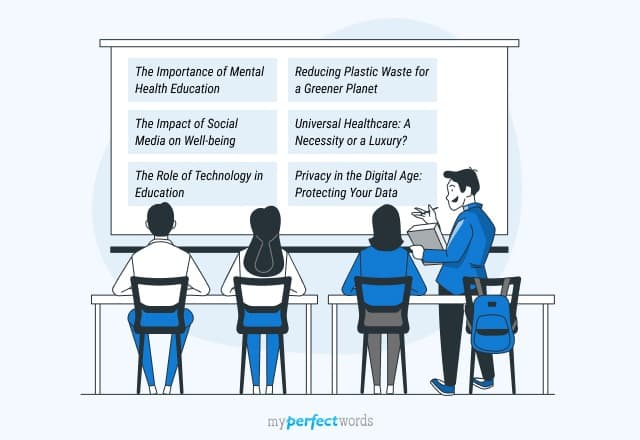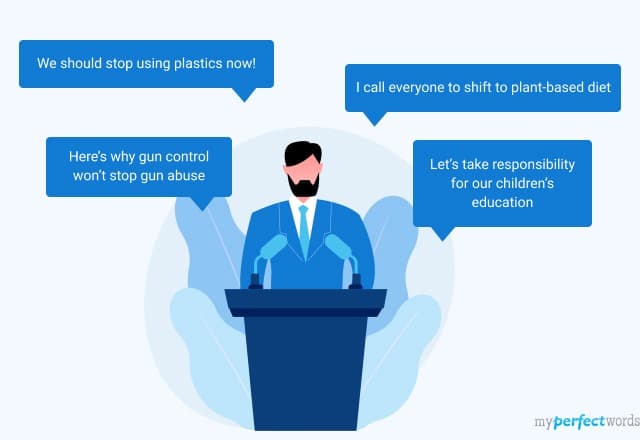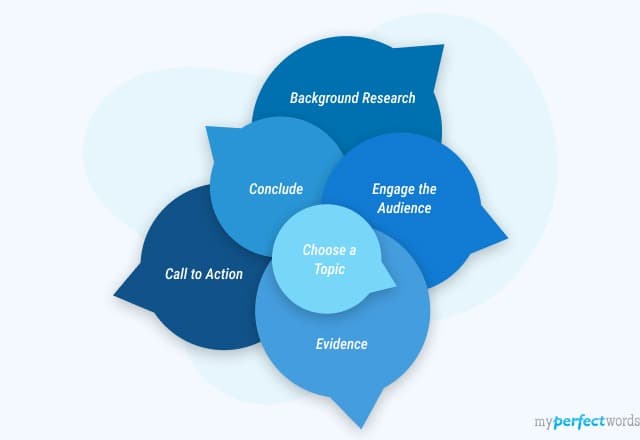Having trouble writing a persuasive speech? You're not alone.
Many students and aspiring orators find themselves wrestling with the complexities of persuasive speech composition.
But fear not! Our comprehensive guide is here to assist you at every step of the way. With easy steps, clear examples, and helpful tips, you’ll be able to refine your persuasive speech writing skills!
So, keep reading!
On This Page![]()
- 1. What is a Persuasive Speech
- 2. Parts of A Persuasive Speech
- 3. How to Write A Persuasive Speech
- 4. Persuasive Speech Examples
- 5. Persuasive Speech Topics
- 6. Tips For Writing A Good Persuasive Speech
What is a Persuasive Speech
A persuasive speech is a type of speech in which the speaker aims to influence the thoughts, opinions, or actions of the audience.
It involves presenting a viewpoint on a specific topic and providing compelling arguments and evidence to convince the listeners. The speaker's objective is to bring about a change in the audience's beliefs, attitudes, or behaviors.
The speaker uses a range of rhetorical techniques, including the persuasive appeals of ethos, pathos, and logos.
- Ethos pertains to the speaker's credibility and character. It involves establishing trust and authority, which makes the audience more receptive to the speaker's message.
- Pathos involves appealing to the emotions and feelings of the audience. It aims to create a strong emotional connection and empathy, making the audience more inclined to take action.
- Logos is about using logic and reason to construct a persuasive argument. It relies on evidence, facts, and clear reasoning to support the speaker's viewpoint.
Parts of A Persuasive Speech
In a persuasive speech, the core sections typically include:
Introduction
The introduction is your opportunity to capture your audience's attention. Start with an engaging hook or attention-grabber.
Provide some background information on the topic to contextualize your argument.
Main Points
Your speech should have two to four main points, each supporting your main argument. Each main point should be a distinct argument that reinforces your overall position.
These arguments serve as the core structure of your speech and should be well-researched and logically presented.
Supporting evidence, examples, or statistics should be included for each main point to bolster your argument and make it more persuasive.
Transitions
Smooth transitions are essential in maintaining the coherence and flow of your speech.
These may be as simple as transition words or sentences that connect one point to the next, ensuring your speech flows logically.
Counterarguments
Recognizing and addressing potential counterarguments or opposing viewpoints is a sign of a well-rounded and well-researched argument. Devote a section of your outline to these counter arguments, acknowledging them in a fair and unbiased manner.
Then, provide a well-reasoned response to refute these opposing views, demonstrating the strength and credibility of your own position.
Conclusion
The conclusion is where you wrap up your speech by summarizing your main points and restating your thesis.
Consider including a call to action in your conclusion to motivate your audience to take a specific step or support your cause. A strong conclusion should provide a clear sense of closure, emphasizing the key takeaways from your speech.
End your speech with a memorable statement that leaves a final impression. You can use a powerful quote, a thought-provoking statement, or a call for reflection.
Additionally, thank your audience for their time and attention, fostering a sense of appreciation and respect for their presence.
How to Write A Persuasive Speech
Writing a persuasive speech is a structured process that makes your message compelling and effective in conveying ideas to the audience.
Here's a step-by-step guide to help you craft a persuasive speech:
Step 1: Choose a Persuasive Topic
Selecting the right topic is the foundation of a persuasive speech. An effective persuasive topic is one that can be debated or has varying viewpoints.
Your chosen topic should be relevant to your audience's interests, beliefs, and concerns. For instance, if you're addressing university students, consider what issues are important to them.
Let's say you choose "The Importance of Mental Health Awareness on Campus" as your topic for a persuasive speech at your college. This topic is relevant, given the high levels of stress and mental health challenges that college students often face.
Step 2: Research Your Topic
To persuade your audience, you have to become an expert in your topic to establish credibility. Gather information, data, and evidence that support your arguments.
For the topic of mental health awareness, research may include finding statistics on mental health issues among college students. Look for academic studies that discuss the impact of mental health on academic performance.
Step 3: Know Your Audience
Understanding your audience is crucial. Consider their attitudes, beliefs, values, and concerns related to your chosen topic.
For a college student audience, it's essential to comprehend their experiences and viewpoints on mental health. By acknowledging their existing knowledge and attitudes, you can tailor your speech to resonate more effectively with them.
Step 4: Organize Your Speech
Like any speech, persuasive speech should follow a logical structure.
Start with a compelling opening, which may include a relevant story, a surprising fact, or a thought-provoking question. Clearly state your main argument here. In the case of mental health awareness, it could be something like,
"Promoting mental health awareness on campus is essential for the well-being and success of college students."
Create a speech outline, which could be structured around the problems, solutions, and a call to action regarding mental health on campus. A speech outline is a blueprint which helps in delivering your persuasive speech in a logically fluent way and convincing your audience.
Here is a sample speech outline:
I. Introduction II. Problems of Mental Health on Campus III. Solutions and Initiatives IV. Call to Action V. Closing |
Step 5: Write the Introduction
Begin with a strong hook to capture your audience's attention. Introduce yourself and explain why you are qualified to speak on the topic.
Clearly state your thesis and preview the main points you will discuss. Understanding the best ways to start your speech can significantly enhance your ability to persuade your audience from the very beginning.
Step 6: Craft Persuasive Arguments
In the body of your speech, you'll present persuasive arguments to support your thesis.
In the "Understanding the Problem" section, talk about rising student stress, mental health stigma, and their impact on academic performance.
Use evidence and examples to back up each argument. Cite specific statistics or sharing stories of students who have faced these challenges.
Step 7: Use Rhetorical Devices
To make your persuasive speech more engaging and relatable to your audience, it's essential to employ rhetorical devices effectively.
These devices add depth and emotional resonance to your message. Some key rhetorical devices to consider include metaphors, anecdotes, and emotional appeals.
Personal stories or anecdotes about mental health issues can create a connection with your audience and evoke empathy.
Step 8: Address Counterarguments
It's important to acknowledge potential counterarguments in your speech. This shows that you've considered multiple perspectives. Acknowledging and refuting opposing views enhances the strength and credibility of your own point of view.
A potential argument could be that mental health awareness is too costly for universities. You can counter this by presenting cost-effective solutions that have been implemented successfully at other institutions.
Step 9: Call to Action
Conclude your speech with a compelling call to action. Encourage your audience to take specific steps to support your cause.
For instance, you could encourage them to participate in mental health awareness campaigns on campus, or advocate for improved mental health services in the university community.
Step 10: Revise and Practice
After writing your speech, revise it for clarity, coherence, and impact.
Practice your delivery multiple times to enhance your confidence and effectiveness as a speaker.
Certain steps can vary according to whichever type of persuasive speech you’re working on.
Persuasive Speech Examples
Examining examples of persuasive speeches can provide valuable insights into what makes a speech effective. Here is an example of a persuasive speech on climate change:
Ladies and gentlemen, today I want to address a critical issue that affects all of us: climate change. Our planet is warming at an unprecedented rate, and the consequences are already visible. We must take immediate action to protect our environment and ensure a sustainable future. Climate change is not a distant threat; it's happening now. The last decade has been the hottest on record. We are witnessing more frequent and severe weather events like hurricanes, droughts, and wildfires. These changes are not just statistics; they are affecting communities worldwide. The primary cause of climate change is the increase in greenhouse gasses, especially carbon dioxide from burning fossil fuels. Deforestation and industrial activities also contribute significantly. To combat this, we must reduce our carbon emissions and transition to renewable energy sources like wind and solar power. We have the tools to fight climate change, but it requires a collective effort. Governments need to implement policies that support green technologies. Businesses should adopt sustainable practices. And as individuals, we can make a difference by reducing waste, conserving energy, and supporting eco-friendly initiatives. In conclusion, climate change is an urgent issue that demands our attention and action. By understanding its causes and working together towards sustainable solutions, we can protect our planet for future generations. The time to act is now. Let's take responsibility and make a positive impact on our environment. Thank you. |
Here are some more persuasive speech examples for helping you:
Want to consult a few more examples? Check out these persuasive speech examples to help you get more ideas!
Persuasive Speech Topics
A good persuasive speech topic is one that grabs your audience's attention and stirs their thoughts.
To choose the right topic, it should be something you truly care about and that's important to your audience members. It's also essential that there are different opinions on the topic because it creates room for a meaningful discussion.
Here are some persuasive speech ideas:
Funny Persuasive Speech Topics
- Why cats are secretly plotting to take over the world.
- The importance of having a designated pizza night every week.
- How to survive a zombie apocalypse with just your wits and a backpack of snacks.
- The merits of watching cute animal videos during work hours.
- Why we should replace final exams with rap battles.
- The best excuses for being late to class (that actually work).
- How to annoy your roommates without getting caught.
- The compelling case for declaring "National Pajama Day."
- The benefits of talking to your houseplants and why they're great listeners.
- Why coffee should be classified as a daily essential nutrient.
Unique Persuasive Speech Topics
- The impact of social media on our sense of self-worth and well-being.
- The need for implementing mindfulness and meditation in schools.
- The benefits of fostering a community garden in every neighborhood.
- Why we should prioritize space exploration and colonizing other planets.
- The importance of teaching coding and programming in elementary schools.
- The ethical implications of gene editing and designer babies.
- Promoting eco-friendly travel options and reducing the environmental impact of tourism.
- The benefits of a four-day workweek for improved productivity and work-life balance.
- The need for teaching financial literacy in high schools.
- The impact of virtual reality on therapy and mental health treatment.
Can’t pick a topic? View this extensive list of persuasive speech topics on different themes!
Tips For Writing A Good Persuasive Speech
Creating and giving a strong persuasive speech involves different steps. Here are some tips for both writing and delivering your speech effectively:
- Learn what your audience cares about and shape your message accordingly.
- Back your points with credible data, facts, expert views, or real-life stories.
- Utilize credibility, emotions, and logic in a way that appeals to the audience.
- Share relatable anecdotes to connect with your audience.
- Time your speech to fit the allotted duration for maximum impact.
- Make good eye contact to connect with your audience and display confidence.
- Maintain open and confident body language; avoid nervous habits.
To wrap it up,
You’ve got all the key steps and tips for making a strong persuasive speech. Now, you can pick the right topic, back it up with solid evidence, and keep your audience engaged.
But if you ever find yourself thinking, "I need someone to help me do my essay," don’t worry—we’re here to be your reliable essay writing service. Let us take care of the writing so you can focus on other things.
Our skilled writers know how to create powerful speeches. Just buy speech from us and get top-quality results with no hassle!
Frequently Asked Questions
What are the three parts of persuasive speech?
A persuasive speech typically comprises three essential parts: ethos, pathos, and logos.
- Ethos refers to the credibility and trustworthiness of the speaker.
- Pathos involves appealing to the audience's emotions.
- Logos focuses on logical arguments and evidence to support the speaker's message.
How to start a persuasive speech?
To start an effective persuasive speech, grab your audience's attention with a compelling hook, such as a surprising fact, question, or powerful quote. Establish your credibility by briefly introducing yourself and highlighting your expertise or connection to the topic. Clearly state your purpose, outlining what you aim to persuade the audience about, and preview the main points you'll cover.
What is the purpose of a persuasive speech?
The primary purpose of a persuasive speech is to convince the audience to accept a particular viewpoint or take a specific action. This involves presenting arguments, evidence, and emotional appeals to sway the audience's beliefs, attitudes, or behaviors in favor of the speaker's position.

Write Essay Within 60 Seconds!
Use our AI tool to generate high quality essay-18976.png&w=256&q=75&dpl=dpl_4f4VU87XynDmuWZvXA7fJDuQ5GRt)
WRITTEN BY
Amanda K.
UPenn English grad completing academic assignments. I deliver quality work across subjects and formats.
Keep reading
Good Persuasive Speech Topics & Ideas for Debaters

200+ Motivational Speech Topics and Ideas To Inspire You (2025)

16 Best Persuasive Speech Examples for Students

Persuasive Speech Outline - Samples, Format, and Writing Tips

3 Basic Types of Persuasive Speeches


